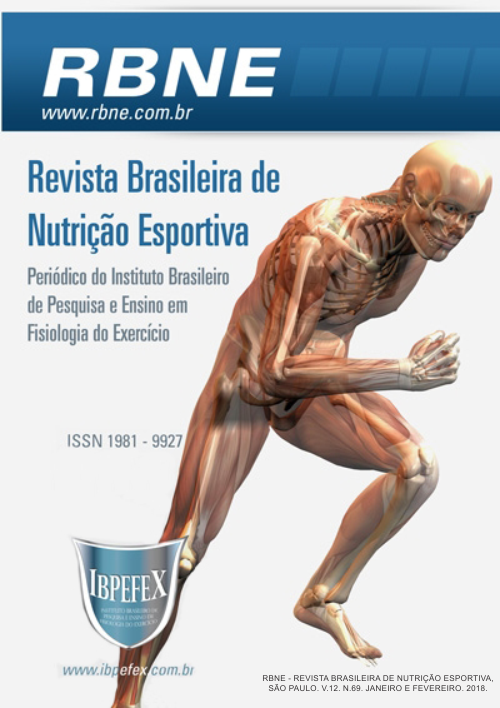State of hydration and body composition of flag american football players
Abstract
Aim: To evaluate the state of hydration and body composition of American football players. Methods: This is a cross-sectional study, conducted with American flag football players, of both sexes from a Guarulhos club. The body composition was evaluated through the measurement of weight, height, skinfolds and body circumferences. The assessment of water loss was made by calculating the sweating rate and percentage of body weight loss. Results: 23 players were evaluated, with a mean age of 23 years. It was observed that seven athletes had a much increased risk for cardiovascular diseases, being also classified as overweight by BMI. However, most players had a low percentage of body fat. In relation to water loss, an athlete was classified as slightly dehydrated; there was a mean of 0.49% weight loss percentage and 1.33 ml / min sweat rate. Most players had symptoms of dehydration such as intense thirst, headache, cramps, and a feeling of loss of strength. Conclusion: It is concluded that there is a need for individualized nutritional monitoring of the team to ensure a good state of hydration and improvement of nutritional status, thus benefiting the training, competition and health of individuals.
References
-Boileau, R.A.; e colaboradores. Exercise and body composition of children and youth. Scandinavian Journal Medicine Science Sports. Copenhagen. Num. 7. 1985. p. 727.
-Burke, E.J.; Winslow, E.; Strube, W.V. Measures of body composition and performance in major college football players. J. Sports Med. Vol. 20. 1980. p.173-180.
-Deurenberg, P.; Pieters, J.J.L.; Hautvast, J.G.A.J. The assessment of the body fat percentage by skinfold thickness measurements in childhood and young adolescence. Br. J. Nutr. Vol. 63. Num. 2. 1990. p. 293-303.
-Drumond, M.G.; Carvalho, F.R.; Guimarães, E.M.A. Hidratação em atletas adolescentes -Hábitos e nível de conhecimento. Revista Brasileira de Nutrição Esportiva. Vol. 1. Num. 2. 2007. p. 76-93. Disponível em: <http://www.rbne.com.br/index.php/rbne/article/view/20/19>
-Ferreira, F.G. Nível de conhecimento dos atletas universitários da UFV sobre a hidratação no exercício. Departamento de Educação Física, Universidade Federal de Viçosa (UFV), 2003.
-Foss, L.M.; Keteyian, S.J. Bases Fisiológicas do Exercício e do Esporte. 6ª edição. Rio de Janeiro. Guanabara Koogan. 2000.
-Freedman, D.S.; Serdula, M.K.; Srinivasan, S.R.; Berenson, G.S. Relation of circumferences and skinfold thickness to lipid and insulin concentration in children and adolescents: the Bogalusa Heart Study. American Journal of Clinical Nutrition, Vol. 69. Num. 2. 1999. p. 308-317.
-Harp, J. B.; Hecht, L. Obesity in the National Football League. The Journal of the American Medical Association. Vol. 293. Num. 9. 2005. p. 1061-1062.
-Jackson, A.S. The effect of sex, age and race on estimatingpercentage body fat from body mass index: The Heritage Family Study. International Journal of Obesity. Vol. 26. 2002. p. 789-796.
-Jackson, A.S.; Pollock, M.L. Practical assessment of body composition. The Physician andSports Medicine. Vol. 13. Num. 5. 1985. p. 76-90.
-Mcardle, W.D.; KatchF. I. Exercício e estresse térmico. In: Fisiologia do exercício: nutrição, energia e desempenho humano. 7ªedição. Guanabara Koogan. 2013.
-Merlo, T.E. Prática e desenvolvimento do Futebol Americano de praia no estado do Rio de Janeiro. Rio de Janeiro. 2005.
-Ministério da Saúde. Antropometria. 2009. Disponível em <http://nutricao.saude.gov.br/documentos/album_antopometria.pdf>. Acesso em: jul de 2009.
-Noel, M.B.; Vanheest, J.L.; Zaneteas, P.; Rodgers, C.D. Body Composition in Division I Football Players. Journal of strength and conditioning research. Vol. 17. Num. 2. 2003. p. 228-237.
-Pinto, S.I.F.; Berdarcki, V.S.; Biesek, S. Avaliação da perda hídrica e do grau de conhecimento em hidratação de atletas de futebol americano. Revista Brasileira de Nutrição Esportiva. Vol. 8. Num. 45. 2014. p. 171-179. Disponível em: <http://www.rbne.com.br/index.php/rbne/article/view/454/418>
-Pollock, M.L.; Wilmore, J.H.; Fox, S.M. Exercícios na saúde e na doença. Rio de Janeiro. Medsi. p. 231-605. 1993.
-Rodrigues, F.X.F.; Costa, N.C.G.; Pedroso L.C.; Silva, J.A. Futebol americano no país do futebol: o caso do cuiabá arsenal. Barbarói. Num. 41. p. 227-247. 2014.
-Sociedade Brasileira de Medicina do Esporte. Diretriz da Sociedade Brasileira de Medicina do Esporte: Modificações dietéticas, reposição hídrica, suplementos alimentares e drogas: comprovação de ação ergogênica e potenciais riscos para a saúde. Revista Brasileira de Medicina do Esporte. Vol. 15. Num. 3. 2009. p. 3-12.
-Tucker, A.M.; Vogel, R.A.; Lincoln, A.E.; Dunn, R.E.; Ahrensfield, D.C.; Allen, T.W.; Castle, L.W.; Heyer, R.A.; Pellman, E.J.; Strollo, P.J.; Wilson, P.W.F.; Yates, A.P. Prevalence of cardiovascular disease risk factors among national football league players. The Journal of the American Medical Association. Vol. 301. Num. 20. 2009. p. 2111-2119.
-William, J.K.; Jon, C.T.; Ricardo, S.; Duncan, N.F.; Nicholas, A.R.; Barry, A.S.; Disa, L.H.; Jakob, L.V.; Jeff, S.V. Body size and composition of national football league players. Journal of strength and conditioning research. Vol. 19. Num. 3. 2005. p. 485-489.
-World Health Organization. Obesity: preventing and managing the global epidemic. Report ofa World Health Organization Consultation. Geneva. Num. 284. 2000. p. 256.
Authors who publish in this journal agree to the following terms:
- Authors retain the copyright and grant the journal the right of first publication, with work simultaneously licensed under the Creative Commons Attribution License BY-NC which allows the sharing of the work with acknowledgment of the authorship of the work and initial publication in this journal.
- Authors are authorized to enter into additional contracts separately for non-exclusive distribution of the version of the work published in this journal (eg, publishing in institutional repository or book chapter), with acknowledgment of authorship and initial publication in this journal.
- Authors are allowed and encouraged to post and distribute their work online (eg, in institutional repositories or on their personal page) at any point before or during the editorial process, as this can bring about productive change as well as increase impact and impact. citation of published work (See The Effect of Free Access).






